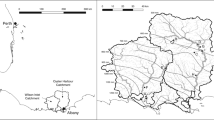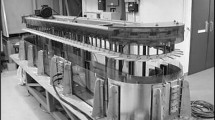Abstract
Sediment resuspension plays a dominant physical role in downstream transport of sediment-bound, or ‘in-place’ pollutants. During resuspension, however, numerous sorption reactions may alter contaminant phase distributions. Previous field resuspension studies on heavily contaminated sediments (Theis et al., 1988, J. Great Lakes Res. 14, 216) showed parallel trends in metal partitioning with pH and time for each of 7 metals (Cd, Co, Cr, Cu, Ni, Pb, Zn), when pH was < 7.5 during resuspension. To improve our ability to interpret follow-up laboratory partitioning experiments using sediments from the field sites, we conducted an evaluation of sediment sample storage as a potential factor leading to field-laboratory partitioning differences. Although metal sorption observed in the laboratory differed substantially from that observed in the field, sample storage effects, reported as holding time and changes in solid phase metal fractionation, gave minimal support for the hypothesis that sample storage caused the differences. It appears, rather, than our in vitro batch equilibrium systems incompletely replicated those attributes of a sediment-water system that are relevant to adsorption and desorption of heavy metals during a resuspension event. Accordingly, we conclude that a general improvement in the understanding of contaminant partitioning would result if future studies would assign greater importance to evaluating the effects of relevant physical phenomena on partitioning (e.g. particle interaction and shear stress), in addition to such widely studied chemical determinants as pH, time, and metal species.
Similar content being viewed by others
References
Davies-Colley, R. J., P. O. Nelson & K. J. Williamson, 1984. Copper and Cadmium uptake by estuarine sedimentary phases. Envir. Sci. Technol. 18: 491–499.
DiToro, D. M., 1985. A particle interaction model of reversible organic chemical sorption. Chemosphere 14: 1503–1538.
Eary, L. E. & D. Rai, 1987. Kinetics of chromium(III) oxidation to chromium(VI) by reaction with manganese dioxide, Envir. Sci. Technol. 21: 1187–1193.
Forstner, U. & G. T. W. Wittmann, 1981. Metal Pollution in the Aquatic Environment, Springer-Verlag, New York.
Fulghum, J. E., Bryan, S. R., R. W. Linton, C. F. Bauer & D. P. Griffis, 1988. Discrimination between adsorption and coprecipitation in aquatic particle standards by surface analysis techniques: lead distributions in calcium carbonates. Envir. Sci. Technol. 22: 463–467.
Gibbs,R., 1977. Transport phases of transition metals in the Amazon and Yukon Rivers, Geol. Soc. Am. Bull. 88: 829–843.
GLWQB, 1987. Great Lakes Water Quality. Annual report of Great Lakes Water Quality Board to International Joint Commission. International Joint Commission, Windsor ON.
Jenne, E. A., 1968. Controls on Mn, Fe, Co, Ni, Cu, and Zn concentrations in soils and water: the significant role of hydrous Mn and Fe oxides. In R. A. Baker (ed.), Trace Inorganics in Water, Advances in Chemistry Series, No. 73, Am. Chem. Soc. Washington, DC: 337–387.
Kreis, R. G., 1988. Integrated study of exposure and biological effects of in-place sediment pollutants in the upper connecting channels: interim results. Final report to the upper Great Lakes connecting channels study activities workgroups for tasks in activities C,G, and H. USEPA/ORD/ERL-D Large Lakes Research Station, Grosse Ile, MI.
Lion, L. W., R. S. Altmann & J. O. Leckie, 1982. Trace metal adsorption characteristics of estuarine particulate matter: evaluation of contributions of Fe/Mn oxide and organic surface coatings. Envir. Sci. Technol. 16: 660–666.
Morel, F. M. M., 1983. Principles of Aquatic Chemistry, Wiley & Sons, New York.
Nriagu, J. O. & R. D. Coker, 1980. Trace metals in humic and fulvic acids from Lake Ontario sediments. Envir. Sci. Technol. 15: 443–446.
Oakley, S. M., P. O. Nelson & K. J. Williamson, 1981. Model of trace-metal partitioning in marine sediments. Envir. Sci. Technol. 15: 474–480.
Rapin, F., A. Tessier, P. G. C. Campbell & R. Carigan, 1986. Potential artifacts in the determination of metal partitioning in sediments by a sequential extraction procedure, Envir. Sci. Technol. 20: 836–840.
Rathbun, J. & E. Smith, 1985. Interim report on the Trenton Channel survey. USEPA/ORD/ERL-D Large Lakes Research Station, Grosse Ile, MI.
Schultz, M. F., M. M. Benjamin & J. F. Ferguson, 1987. Adsorption and desorption of metals on ferrihydrite: reversibility of the reaction and sorption properties of the regenerated solid, Envir. Sci. Technol. 21: 863–869.
Tessier, A., P. G. C. Campbell & M. Bisson, 1979. Sequential extraction procedure for the speciation of particulate trace metals, Analyt. Chem. 51: 844–851.
Tessier, A., P. G. C. Campbell & M. Bisson, 1982. Particulate trace metal speciation in stream sediments and relationships with grain size: Implications for geochemical exploration, J. Geochem. Explor. 16: 77–104.
Theis, T. L., 1985. Equilibrium and kinetic descriptions of sorption reactions on hydrous oxide surfaces. USEPA Report No. 600/X-85/122, Office of Exploratory Research, Washington, DC.
Theis, T. L., T. C. Young & J. V. DePinto, 1988. Factors affecting metal partitioning during resuspension of sediments from the Detroit River. J. Great Lakes Res. 14: 216–226.
Author information
Authors and Affiliations
Rights and permissions
About this article
Cite this article
Young, T.C., Waltman, M.R., Theis, T.L. et al. Studies of heavy metal sorption by Trenton Channel (Detroit River) sediments. Hydrobiologia 235, 649–660 (1992). https://doi.org/10.1007/BF00026253
Issue Date:
DOI: https://doi.org/10.1007/BF00026253




